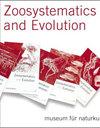A new species of land snail, Xanthomelon amurndamilumila, from the North East Isles off Groote Eylandt (= Ayangkidarrba), Gulf of Carpentaria, Australia (Stylommatophora, Camaenidae)
IF 1.6
2区 生物学
Q2 ZOOLOGY
引用次数: 0
Abstract
This paper introduces Xanthomelon amurndamilumilasp. nov., a newly-discovered land snail species inhabiting the North East Isles, offshore from Groote Eylandt (= Ayangkidarrba), north-western Gulf of Carpentaria, in the Northern Territory, Australia. Specimens of this species were first collected during the 2021 Bush Blitz expedition to Groote Eylandt, a large offshore archipelago previously unexplored for land snails. The taxonomic status of the new species was established through a comprehensive analysis of comparative morphology and mitochondrial genetics: X. amurndamilumila forms a maximally supported clade closely related to X. arnhemense and is characterised by a unique combination of morphological characteristics, including smaller shell size, distinctive sculpture of collabral ridges and specific features of its reproductive anatomy. The genetic divergence and phylogenetic relationships suggest historical isolation. While the discovery of X. amurndamilumilasp. nov. enriches our understanding of land snail diversity in the Northern Territory, its conservation status is of concern on North East Island because of habitat degradation caused by feral deer.来自澳大利亚卡奔塔利亚湾 Groote Eylandt(= Ayangkidarrba)附近东北群岛的一种新陆螺 Xanthomelon amurndamilumila(蜗牛科,蜗牛属)。
本文介绍了新发现的陆螺物种 Xanthomelon amurndamilumilasp.该物种的标本是在 2021 年对 Groote Eylandt 进行 "丛林闪电战 "探险时首次采集到的。通过对比较形态学和线粒体遗传学的全面分析,确定了该新物种的分类地位:X. amurndamilumila 形成了一个与 X. arnhemense 关系密切的最大支持支系,并具有独特的形态特征组合,包括较小的壳体尺寸、独特的壳脊雕刻及其生殖解剖的特殊特征。其遗传分化和系统发育关系表明其在历史上是孤立的。X. amurndamilumilasp. nov.的发现丰富了我们对北领地陆地蜗牛多样性的了解,但由于野鹿造成的栖息地退化,其在东北岛上的保护状况令人担忧。
本文章由计算机程序翻译,如有差异,请以英文原文为准。
求助全文
约1分钟内获得全文
求助全文
来源期刊

Zoosystematics and Evolution
ZOOLOGY-
CiteScore
3.50
自引率
5.00%
发文量
34
审稿时长
16 weeks
期刊介绍:
Zoosystematics and Evolution, formerly Mitteilungen aus dem Museum für Naturkunde in Berlin, is an international, open access, peer-reviewed life science journal devoted to whole-organism biology. It publishes original research and review articles in the field of Metazoan taxonomy, biosystematics, evolution, morphology, development and biogeography at all taxonomic levels. The journal''s scope encompasses primary information from collection-related research, taxonomic descriptions and discoveries, revisions, annotated type catalogues, aspects of the history of science, and contributions on new methods and principles of systematics. Articles whose main topic is ecology, functional anatomy, physiology, or ethology are only acceptable when of systematic or evolutionary relevance and perspective.
 求助内容:
求助内容: 应助结果提醒方式:
应助结果提醒方式:


